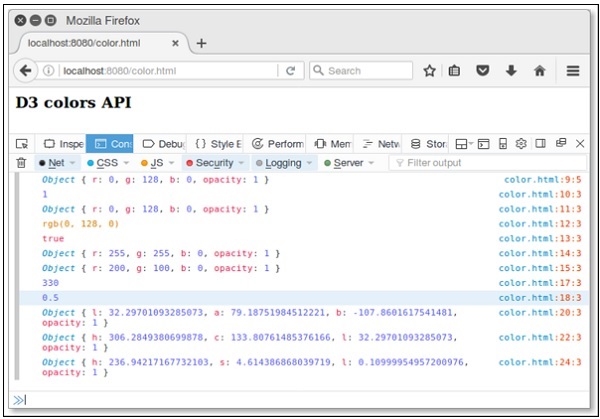Colors are displayed combining RED, GREEN and BLUE. Colors can be specified in the following different ways −
- By color names
- As RGB values
- As hexadecimal values
- As HSL values
- As HWB values
The d3-color API provides representations for various colors. You can perform conversion and manipulation operations in API. Let us understand these operations in detail.
Configuring API
You can directly load API using the following script.
<script src = "https://d3js.org/d3-color.v1.min.js"></script>
<script>
</script>Basic Operations
Let us go through the basic color operations in D3.
Convert color value to HSL − To convert color value to HSL, use the following Example −
var convert = d3.hsl("green");You can rotate the hue by 45° as shown below.
convert.h + = 45;Similarly, you can change the saturation level as well. To fade the color value, you can change the opacity value as shown below.
convert.opacity = 0.5;Color API Methods
Following are some of the most important Color API Methods.
- d3.color(specifier)
- color.opacity
- color.rgb()
- color.toString()
- color.displayable()
- d3.rgb(color)
- d3.hsl(color)
- d3.lab(color)
- d3.hcl(color)
- d3.cubehelix(color)
Let us understand each of these Color API Methods in detail.
d3.color(specifier)
It is used to parse the specified CSS color and return RGB or HSL color. If specifier is not given, then null is returned.
Example − Let us consider the following example.
<script>
var color = d3.color("green"); // asign color name directly
console.log(color);
</script>We will see the following response on our screen −
{r: 0, g: 128, b: 0, opacity: 1}
color.opacity
If we want to fade the color, we can change the opacity value. It is in the range of [0, 1].
Example − Let us consider the following example.
<script>
var color = d3.color("green");
console.log(color.opacity);
</script>We will see the following response on the screen −
1
color.rgb()
It returns the RGB value for the color. Let us consider the following example.
<script>
var color = d3.color("green");
console.log(color.rgb());
</script>We will see the following response on our screen.
{r: 0, g: 128, b: 0, opacity: 1}
color.toString()
It returns a string representing the color according to the CSS Object Model specification. Let us consider the following example.
<script>
var color = d3.color("green");
console.log(color.toString());
</script>We will see the following response on our screen.
rgb(0, 128, 0)
color.displayable()
Returns true, if the color is displayable. Returns false, if RGB color value is less than 0 or greater than 255, or if the opacity is not in the range [0, 1]. Let us consider the following example.
<script>
var color = d3.color("green");
console.log(color.displayable());
</script>We will see the following response on our screen.
true
d3.rgb(color)
This method is used to construct a new RGB color. Let us consider the following example.
<script>
console.log(d3.rgb("yellow"));
console.log(d3.rgb(200,100,0));
</script>We will see the following response on the screen.
{r: 255, g: 255, b: 0, opacity: 1}
{r: 200, g: 100, b: 0, opacity: 1}
d3.hsl(color)
It is used to construct a new HSL color. Values are exposed as h, s and l properties on the returned instance. Let us consider the following example.
<script>
var hsl = d3.hsl("blue");
console.log(hsl.h + = 90);
console.log(hsl.opacity = 0.5);
</script>We will see the following response on the screen.
330
0.5
d3.lab(color)
It constructs a new Lab color. The channel values are exposed as ‘l’, ‘a’ and ‘b’ properties on the returned instance.
<script>
var lab = d3.lab("blue");
console.log(lab);
</script>We will see the following response on the screen.
{l: 32.29701093285073, a: 79.18751984512221, b: -107.8601617541481, opacity: 1}
d3.hcl(color)
Constructs a new HCL color. The channel values are exposed as h, c and l properties on the returned instance. Let us consider the following example.
<script>
var hcl = d3.hcl("blue");
console.log(hcl);
</script>We will see the following response on the screen.
{h: 306.2849380699878, c: 133.80761485376166, l: 32.29701093285073, opacity: 1}
d3.cubehelix(color)
Constructs a new Cubehelix color. Values are exposed as h, s and l properties on the returned instance. Let us consider the following example.
<script>
var hcl = d3.hcl("blue");
console.log(hcl);
</script>We will see the following response on the screen,
{h: 236.94217167732103, s: 4.614386868039719, l: 0.10999954957200976, opacity: 1}
Working Example
Let us create a new webpage – color.html to perform all the color API methods. The complete code listing is defined below.
<html>
<head>
<script type = "text/javascript" src = "https://d3js.org/d3.v4.min.js"></script>
</head>
<body>
<h3>D3 colors API</h3>
<script>
var color = d3.color("green");
console.log(color);
console.log(color.opacity);
console.log(color.rgb());
console.log(color.toString());
console.log(color.displayable());
console.log(d3.rgb("yellow"));
console.log(d3.rgb(200,100,0));
var hsl = d3.hsl("blue");
console.log(hsl.h + = 90);
console.log(hsl.opacity = 0.5);
var lab = d3.lab("blue");
console.log(lab);
var hcl = d3.hcl("blue");
console.log(hcl);
var cube = d3.cubehelix("blue");
console.log(cube);
</script>
</body>
</html>Now, request the browser and we will see the following response.https://www.tutorialspoint.com/d3js/src/color.htm

Leave a Reply